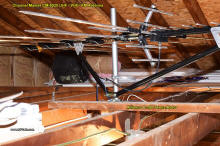Channel Master Yagi Antenna Ad |
||
The Channel Master CM3020 Advantage 100 is a 50-element combination HDTV/VHF/UHF/FM log periodic design with an advertised range of up to 100 miles. VHF gain 8.6 dB and UHF gain 9.5 dB, with a front-to-back ratio of 16 dB. I'll need to do a little research on what height will be needed for decent performance. Having the rotator with a good directional antenna is key to good reception. Channel Master Yagi Antenna - Tests Reveal Serious Mismatch in Stacked Yagis! Z-Match, New Development, Achieves 100% Perfect Match To 300 Ohm Line, Single or Stacked. Higher Gain On All Yagi Installations Accomplished By Adjustable Impedance And Wider Spaced Elements. Now! Stack Yagis without extra stacking bars! Mismatch eliminated! Now Channel Master proudly introduces Z-Match - a system that guarantees 100% perfect match in both single and stacked Yagi installations. Single bay Yagi perfectly matches 300 ohms because of wider spaced elements. When Yagis are stacked, the center bars of the folded dipoles are removed and used as half-wave connecting rods. This reduces the impedance of each antenna, and automatically creates a perfect 300 ohm match for the complete stacked Yagi array. The Z-Match system, plus wide spacing, provide higher gain for Channel Master Yagis, single or stacked. No extra stacking bars result in lower cost. Gain of Z-Match Yagi on Channel 4 How to Stack Yagis with 100% Efficiency New System Eliminates Mismatch; Provides Higher Gain For Yagis Acting on the complaint of installers of all makes of Yagi antennas that only a small additional gain was achieved in stacking, Channel Master Laboratories engaged in a thorough research project during the past summer. The engineers came up with the new Z-Match system, and, like all important discoveries, it is relatively simple. They noted that although all single Yagis claim to match 300 ohm line, they are stacked one-half-wave with 3/8" connecting rod transformers spaced about 3" apart, with an impedance of 325 ohms. Each Yagi's impedance, therefore, was stepped up to 350 ohms, with the two in parallel totaling only 175 ohms. This meant a mismatch of almost 2:1 when used with 300 ohm line. (Fig. 1 lower right) Channel Master engineers reasoned that in stacking, the impedance of' each single 300 ohm Yagi must be reduced in order for the total stacked Yagi to match a 300 ohm line, as follows: 1. Let the single Yagi match 300 ohm line perfectly when used alone. 2. Reduce Z (impedance) of each Yagi to 200 ohms for stacking. 3. Use 3/8" half-wave connecting rod transformers spaced at 3 1/8". 4. These connecting rod transformers have an impedance of 350 ohms. 5. These 350 ohm connecting rods transform each 200 ohm impedance to 600 ohms. 6. The two 600 ohm impedances in parallel equal 300 ohms. 7. Therefore a perfect match is achieved in both single and stacked antennas! (Fig. 2) A) 3 element 1/2 wave folded dipole of single Yagi showing center bar. B) 2 half-wave folded dipoles with center bars removed. C) Center bars used as stacking rods. The new Z·Match system automatically provides for lowering the impedance of each Yagi when preparing it for stacking. A 600 ohm, 3 conductor folded dipole (Fig. A) is used on the single Yagi to provide a perfect 300 ohm impedance. In stacking, the center bar is taken out of the folded dipole which lowers the impedance to 200 ohms and leaves a pair of 3/8" rods one-half-wave long (Fig. B). These are then used as connecting rods and the result is a stacked Yagi which perfectly matches a 300 ohm line (Fig. C). In order to provide a perfect 300 ohm impedance for the single Yagi, the crossarm had to be lengthened, resulting in higher gain for the Z-Match single Yagi. The antenna is wider spaced than most other commercial Yagis which use a half-wave crossarm. Furthermore, the cost of extra connecting rods is completely eliminated. Z-Match is an exclusive feature of Channel Master Yagi antennas. Completely pre-assembled. Channel Master Corp. Napanoch Road, Ellenville, N. Y. Write for complete technical literature.
Posted May 6, 2022 |
||


